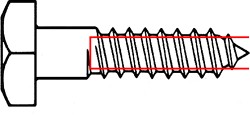Does anyone know the exact correct hole size to drill for an M10 coach screw?
The guys at the hardware shop were guessing more or less. I called EDL (they are EDL brand fasteners) but there was a bit of a silence before the guy kind of took a guess at 10mm - incorrect, that is the outer shaft size. They are going to look up some technical manuals and get back to me on that one.
Kind of surprised. I figure it will be a well known metric standard, but my googling has failed so far.



